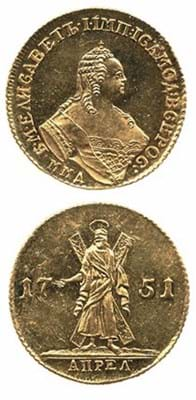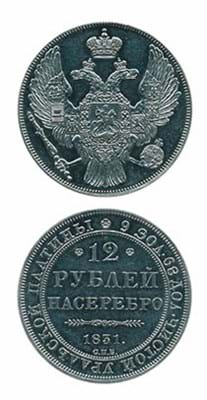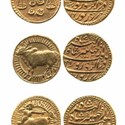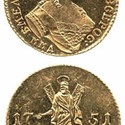It is not surprising that they would wish to buy back their history and there are scarcely any historical documents more generally available than coins.
Three of the ten highest prices achieved at the general sale at Spink (15% buyer's premium) on March 31 were for Russian coins and they achieved prices that very much surpassed their estimates.
In passing I venture to suggest that higher Russian estimates in future sales might, just might, be imprudent. However facts are facts.
The Elizabeth 1751 St Andrew double ducat was estimated at £2000-2500. It made £14,000. This was not a fluke. The 1831 platinum 12 roubles was forecast at £4000-5000. It went for £11,000.
Lest this should not convince you, observe the 1834 Nicholas I platinum six roubles: £1800-2300 was suggested. You guessed it; it took a bid of £9000 - enough said. It seems that interest is particularly intense if the coin comes from an old collection.
The total was £311,915 for the 543 lots sold out of the 610 lots offered (failure rate was a low 10 per cent).
Coins of the Zodiac
Now for a romantic story and, as romantic stories tend to go, actualité is eclipsed.
It goes like this: the Mughal Emperor Jahangir (1605-28) had a beloved wife and as a present she was to be ruler for a single day.
Predicting her favour, she had dies prepared for a magnificent set of mohurs (gold coins) bearing the signs of the Zodiac which was quite daring in a Muslim kingdom.
Alas, like so much that is romantic, the story is just that - a pretty story. The coins have different dates and months on them. The tale emanates from the celebrated traveller and diamond purveyor Jean-Baptiste Tavernier who was at Agra in 1640-41.
The story was not printed until 1684. This is worth noting because it is a myth oft related in connection with these coins. For all that, they are still wonderful coins and only very occasionally come on to the market. In Spink's sale there were five of them.
Now for the results: Aries: £900 (estimate £400-500); Taurus: £3700 (estimate £1700-2200); Libra: £3200 (estimate £1800-2300); Sagittarius, perhaps the rarest and indeed the most splendid of them all: £5400 (estimate £1700-2200); and Pisces: £750 (estimate £400-500).
There are examples in silver, but only for five of the signs. I recall a set sold in Amsterdam in 1904. Four different silver ones turned up at Sotheby's in 1985. Then they realised: Aries: £220, Taurus: £260, Gemini: £240 and Leo: £250. They are even rarer but, of course, proved not so pricey on the few occasions that they appeared on the market. I suggest that today's price would hover round about the £500 mark.
I also speculate that it would be hard to assemble a complete set of the dozen in gold. The British Museum has a set (some from the collection of George III) as does the Ashmolean (formerly in the collection of Christ Church College). Other sets are in Berlin, Paris, Glasgow, Vienna, Leningrad and New York.
Doubtless there are a few others but they seem to have been assembled perhaps as long ago as when the coins were first produced. Spink sold a set for £64 in 1889, perhaps they know what happened to it? There was a complete set on offer in the trade in November 1978 at the then eye-watering price of £12,000. Perhaps it is still around.
Russian market maintains strength as Muslim coins meet the Zodiac
A SECTION of the market which is very firm is that for Russian coins. There are a lot of recently enriched Russians who have been able to transfer their wealth out of the country.










